Putting Materials to Metaphor in the Work of Maria Sibylla Merian
With the help of NU-ACCESS, doctoral candidate Olivia Dill is investigating the pigments used in three 18th-century Merian prints, but the scientific analysis has inspired new questions about the prints’ provenance.
When we look at the natural world, our eyes are often caught by a sheen or iridescence. It can be from a shard of obsidian, the back of a June beetle, or just the light reflecting off the morning dew. But when it comes to capturing that sheen in words or art, it’s easy for things to get lost in translation.
Olivia Dill is a doctoral candidate in the art history department at Northwestern University. For the focus of part of her dissertation, she was interested in using the tools and techniques of the Center for Scientific Studies in the Arts (NU-ACCESS) to study how one artist attempts to capture sheen, or more specifically, glanz, in their work.Glanz is Dutch for sheen, or gloss, and it was often mentioned in the work of Maria Sibylla Merian, a German-born naturalist and illustrator active in the late 17th and early 18th century. She was the focus of Dill’s research, and today, Merian is considered one of the most important women scientists of the Enlightenment era.
In 1699, Merian self-funded a trip to the then Dutch colony of Suriname. It was virtually unheard of at the time for a scientist, let alone a female scientist, to fund their own excursion. For two years, Merian collected and studied specimens, and in 1705 she self-published her most renowned book, Metamorphosis insectorum Surinamensium (The Metamorphosis of the Insects of Suriname). In it, she included vivid copperplate engravings and descriptions of 186 insect species and their life cycles. 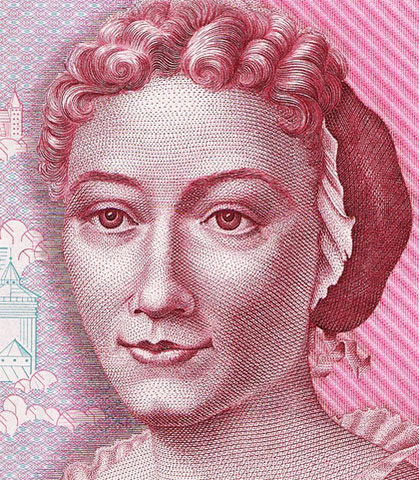
Courtesy of Wiki Commons.
It is partly the vividness of Merian’s illustrations and descriptions that drew Dill to her work, but also how Merian talks about those who helped her studies in Suriname. She is very explicit in Metamorphosis about how enslaved Black people and indigenous people contributed to her research through acts such as bringing her specimens or explaining their uses in the community.
“I chose this work [because] it makes clear the involvement and the entanglement of different types of knowledge that sometimes can get overlooked in studying early modern science.”
According to Dill, in the descriptions in Metamorphosis, Merian repeatedly talks of the glanz of particular insects, and Merian often writes that this sheen is indescribable, that she “cannot describe it with brush or with a pen.” In addition, Dill says shininess has its own aesthetic significance in many indigenous groups based on other reading she has done.“The fact that Merian flags it as something significant is really interesting and is one of these sites of entanglement and connection between all these different knowledge systems,” she says.
Therefore, Dill, in conjunction with NU-ACCESS, wanted to “put materials to a metaphor” and answer what materials, what pigments, does Merian use to describe the indescribable?
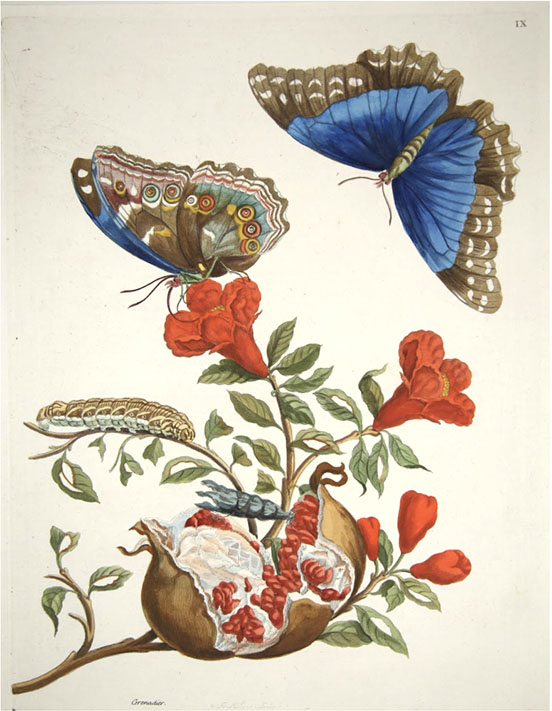
Photo courtesy of Olivia Dill.
There is one reference to glanz that Dill was particularly interested in, a Menelaus blue morpho butterfly (Morpho menelaus) on print from a 1705 edition of Metamorphosis kept in the Charles Deering McCormick Library of Special Collections at Northwestern.
Dill hypothesized that Merian had used the pigment ultramarine blue for the butterfly to represent its glanz. But in order to confirm or deny that, she had to turn to science. First, Dill and the NU-ACCESS team used hyperspectral imaging to gain insight into the pigment Merian used. The technique, also known as visible reflectance imaging, involves shining visible light at an artwork and capturing the response.
According to Marc Vermeulen, a research associate at NU-ACCESS who worked on the Merian team and has pigment analysis expertise, how a material absorbs and reflects different wavelengths of light on the electromagnetic spectrum determines the color we see.
A standard digital photo, such as you might take with your phone can only capture three wavelengths of light: red, green, and blue, but a hyperspectral camera can capture 240 wavelengths, Dill says.
“Based on the interaction between the materials and the light...the reflectance curve may give us a very clear and characteristic spectrum, that will allow us to see which pigment has been used,” Vermeulen says.
But when the butterfly print was analyzed using hyperspectral imaging, Vermeulen noticed that the reflectance curve did not match up with ultramarine blue. Ultramarine blue tends to reflect in the red and orange region of the spectrum, he says. But the pigment used on the butterfly actually absorbed most of the light from that region of the spectrum, pointing to the use of Prussian blue.
But the presence of Prussian blue meant much more than just a different use of pigment because Prussian blue was not available for common use until 1724, says Vermuelen. This print from Special Collections was supposed to be from 1705. However, there was a third edition of the book published in 1730, when the use of Prussian blue could be plausible. So the team thought it was possible the date of the print could just be incorrect and turned to more analysis.
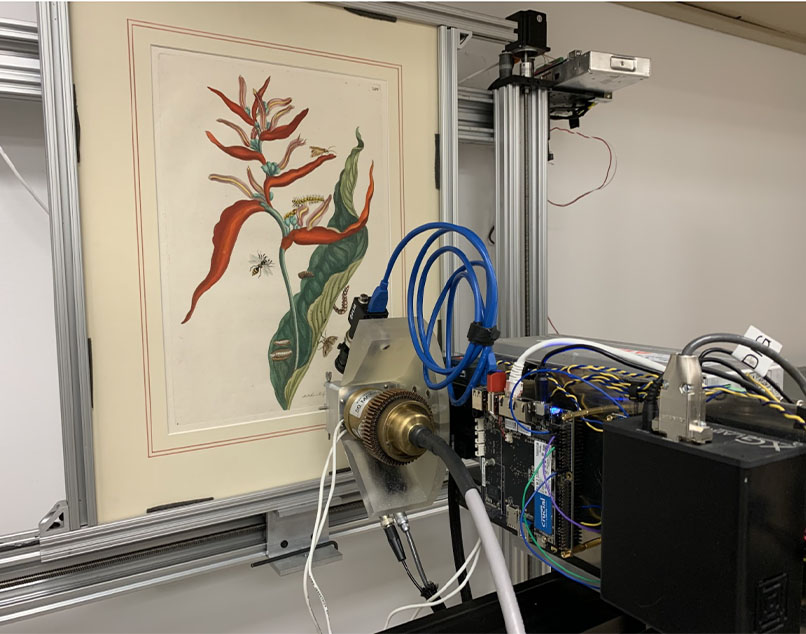 Courtesy of Marc Vermeulen.
Courtesy of Marc Vermeulen.
Next, they used macro X-ray fluorescence (MA-XRF) to dig deeper into the elemental makeup of the pigments used on the butterfly print. MA-XRF is a non-destructive technique used for elemental mapping of large, usually flat, surfaces like prints and paintings.
Alicia McGeachy is a Mellon Foundation postdoctoral fellow with NU-ACCESS with expertise in spectroscopy who also worked on the Merian team. McGeachy thinks of MA-XRF as a “call and response technique.”
“Basically, you throw x-rays at something and you get light back at different wavelengths, and depending on the wavelength, you can specify what [element] is present,” Dill says.
That emission can point to specific elements present, not only in the pigment but also in the paper or any binders used, McGeachy says.
When using XRF analysis, the team was looking for elemental clues that could point to the pigment of the blue butterfly. According to McGeachy, ultramarine blue, the pigment Dill originally hypothesized, contains sodium, aluminum, and sulfur, but looking at the XRF data, there was also a lot of iron. This pointed to the presence of the same culprit as before: Prussian blue.
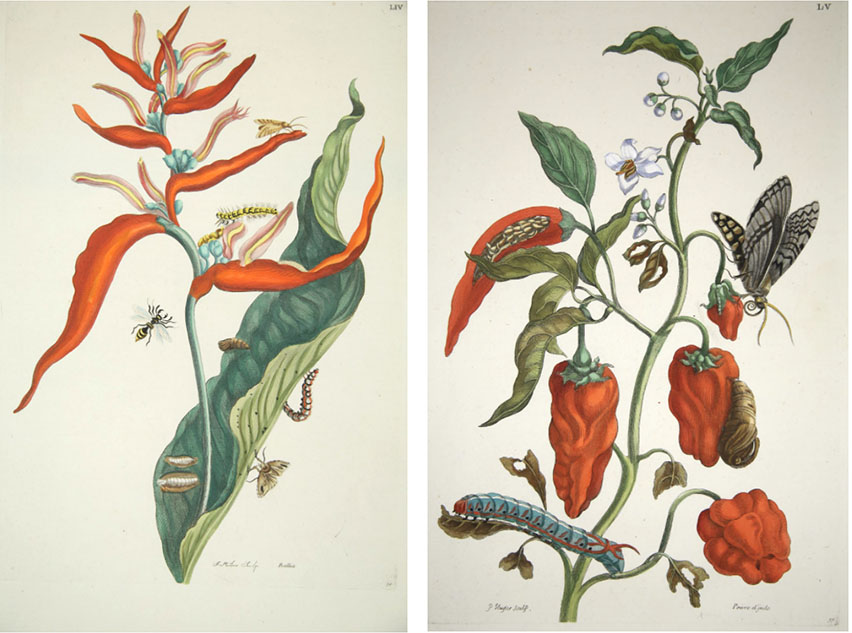
Prints courtesy of Charles Deering McCormick Library of Special Collections at Northwestern.
Photos courtesy of Olivia Dill.
Special Collections also had two more Merian prints from Metamorphosis: one of a red Heliconia flower (Heliconia acuminata) and another of a cherry pepper (Capsicum annuum) with a white flower. More broadly, Dill’s dissertation seeks to understand what pigments Merian used in all three prints, so they also conducted hyperspectral imaging and XRF analysis of the other two.In the red of the flower, the data pointed to the presence of cadmium and in the white of the pepper’s flower, it pointed to the presence of titanium. Not only were cadmium red and titanium white not available in 1705 or 1730, they didn’t even become available until the 20th century.
“Many early modern prints have been re-colored centuries since they were made. So in some ways, it's not surprising,” Dill says, “But it does put a wrinkle in things.”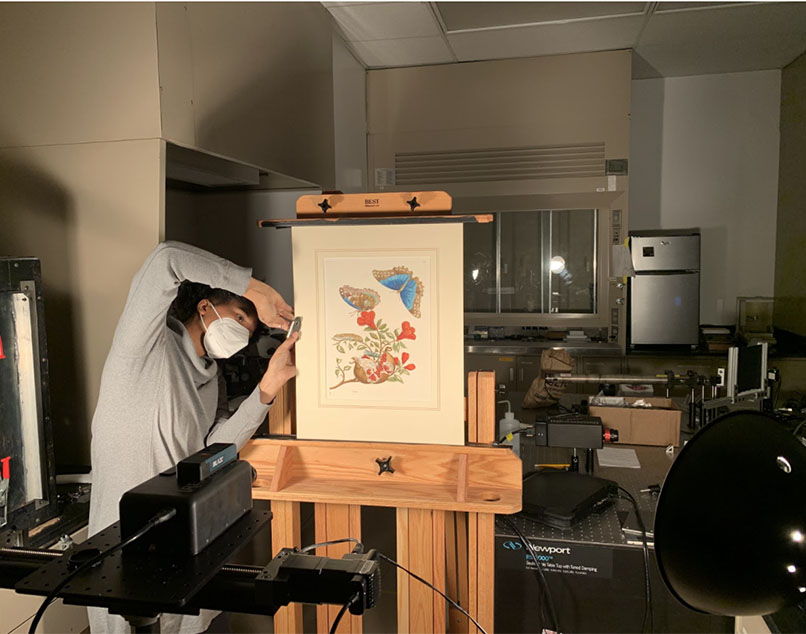 Courtesy of Marc Vermeulen.
Courtesy of Marc Vermeulen.
Until then, there’s still so much value in the research the team has already conducted and what the journey of their research tells us about art history.
“When you're looking at an artwork, it is the product of many years of accumulated time, intervention, and decay,” Dill says. “It is an object that has existed on a long timeline. It is not pristinely plucked from the 18th century and placed in front of you.”Sources:
